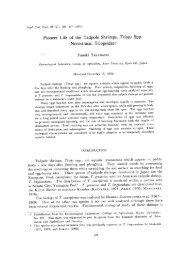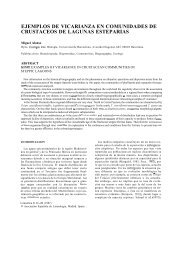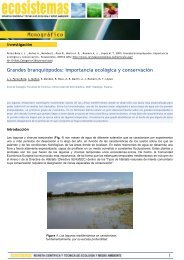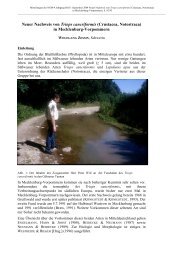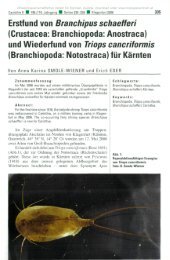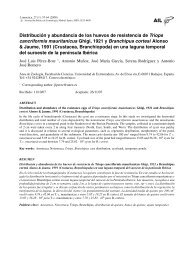Reproductive isolation and genetic differentiation in North American ...
Reproductive isolation and genetic differentiation in North American ...
Reproductive isolation and genetic differentiation in North American ...
You also want an ePaper? Increase the reach of your titles
YUMPU automatically turns print PDFs into web optimized ePapers that Google loves.
140<br />
from southern India is the exception, but this record is<br />
questionable.<br />
Our f<strong>in</strong>d<strong>in</strong>g that profound <strong>genetic</strong> differences<br />
between Triops species are accompanied only by subtle<br />
morphological differences raises serious doubts about<br />
the extensive synonymy of T. longicaudatus. Although<br />
some populations, particularly those associated with<br />
agricultural practices, may have been transported long<br />
distances by human commerce relatively recently, it<br />
seems unlikely that most non-<strong>North</strong> <strong>American</strong> populations<br />
have had extensive gene flow with <strong>North</strong> <strong>American</strong><br />
populations <strong>in</strong> the recent past. Our estimates of<br />
<strong>isolation</strong> distances suggest that, even under the best of<br />
circumstances, populations lose <strong>genetic</strong> cohesion when<br />
separated by more than a few hundred km. Populations<br />
<strong>in</strong> the West Indies, <strong>in</strong> South America, <strong>and</strong> throughout<br />
the Pacific, are separated from <strong>North</strong> <strong>American</strong> populations,<br />
<strong>and</strong> from each other, by far larger distributional<br />
gaps. Furthermore, we have been unable to identify<br />
non-<strong>North</strong> <strong>American</strong> material with either of our unisexual<br />
groups. A prelim<strong>in</strong>ary morphological comparison<br />
of several specimens from Salta Prov<strong>in</strong>ce <strong>in</strong> northern<br />
Argent<strong>in</strong>a, <strong>and</strong> a large lot of material from Aruba with<br />
unisexual T. longicaudatus <strong>and</strong> T. newberryi was <strong>in</strong>conclusive.<br />
Meristic counts did not clearly correspond to<br />
either of the two <strong>North</strong> <strong>American</strong> species. We therefore<br />
believe that the status of all non-<strong>North</strong> <strong>American</strong> forms<br />
attributed to T. longicaudatus requires re-evaluation.<br />
Generalizations to other Notostraca<br />
A corollary of our analysis of T. longicaudatus is that<br />
the morphological <strong>and</strong> life history variability of other<br />
nom<strong>in</strong>al species of Notostraca may also reflect <strong>genetic</strong><br />
<strong>differentiation</strong> <strong>and</strong> speciation. Most other tadpole<br />
shrimps have extensive synonymies; many have extensive<br />
ranges with large discont<strong>in</strong>uities <strong>in</strong> their distributions;<br />
many are morphologically variable; <strong>and</strong> some<br />
show significant variation <strong>in</strong> reproductive mode. Variation<br />
<strong>in</strong> Lepidurus Leach has received some attention,<br />
<strong>and</strong> the synonymies of L<strong>in</strong>der <strong>and</strong> Longhurst have not<br />
been substantiated by the more recent exam<strong>in</strong>ation<br />
of <strong>North</strong> <strong>American</strong> <strong>and</strong> European forms. There has<br />
been far less attention to questions of species identity<br />
with<strong>in</strong> Triops. Triops cancriformis (Bosc), for example,<br />
has an extensive synonymy (Longhurst, 1955a),<br />
exhibits geographic variation <strong>in</strong> sex ratio (<strong>and</strong> presumably<br />
reproductive mode) that is comparable to that<br />
seen <strong>in</strong> <strong>North</strong> America (Zaffagn<strong>in</strong>i & Trent<strong>in</strong>i, 1980),<br />
<strong>and</strong> is morphologically heterogeneous on both local<br />
(Hempel-Zawitkowska, 1968) <strong>and</strong> larger scales (Fryer,<br />
1988). Some authors recognize subspecies of T. cancriformis<br />
(e.g., Thiéry, 1987; Brtek & Thiéry, 1995), but<br />
stronger <strong>isolation</strong> <strong>and</strong> <strong>genetic</strong> <strong>differentiation</strong> may exist.<br />
Triops granarius (Lucas) also exhibits substantial morphological<br />
heterogeneity over its extensive geographical<br />
range (Barnard, 1920; 1929; Gurney, 1924; 1925;<br />
Thiéry, 1987; Tiwari, 1951; 1954; Kar<strong>and</strong>e & Inamdar,<br />
1959; Rayner & Bowl<strong>and</strong>, 1985; Shanbhag &<br />
Inamdar, 1968; Me<strong>in</strong>tjes et al., 1994; Hamer & Rayner,<br />
1995). Although unisexual populations of T. granarius<br />
have not been reported (nor has evidence of<br />
hermaphroditism) there are female-biased populations<br />
(Sassaman, 1991) <strong>and</strong> populations <strong>in</strong> which the normal<br />
sexual dimorphism of the caudal furci is lack<strong>in</strong>g (Gurney,<br />
1924; 1925), as we have found it to be <strong>in</strong> T. newberryi.<br />
The lesser variation <strong>in</strong> T. australiensis (Spencer<br />
& Hall) is accompanied by a simpler synonymy; nevertheless,<br />
the variation that is present (Ma<strong>in</strong>, 1953) may<br />
have a <strong>genetic</strong> component worthy of exam<strong>in</strong>ation.<br />
Conclud<strong>in</strong>g remarks<br />
Triops has a long fossil record; specimens assigned<br />
to this genus are reported from the Permian of Oklahoma<br />
(Ruedemann, 1922) <strong>and</strong> numerous specimens<br />
<strong>in</strong>dist<strong>in</strong>guishable from modern Triops cancriformis<br />
have been collected <strong>in</strong> Triassic formations of Virg<strong>in</strong>ia<br />
(Gore, 1986) <strong>and</strong> Germany (Trusheim, 1937). Two<br />
species described from the Middle Jurassic of Ch<strong>in</strong>a<br />
also resemble T. cancriformis (Chen, 1985). Although<br />
this fossil record represents one of the most remarkable<br />
examples of morphological stasis, it does not record<br />
historical changes <strong>in</strong> the reproductive biology or population<br />
<strong>genetic</strong>s of these organisms. Our results suggest<br />
that small morphological differences may nevertheless<br />
be accompanied by profound <strong>genetic</strong> <strong>differentiation</strong>,<br />
yet relatively large morphological differences<br />
may arise between closely related forms. A key feature<br />
<strong>in</strong> the evolutionary diversification of Triops may be the<br />
aquisition of alternatives to gonochoric reproduction.<br />
Androdioecy (sensu Sassaman, 1995) <strong>and</strong> parthenogenesis<br />
allow an unrestricted opportunity for local <strong>differentiation</strong><br />
that may <strong>in</strong>augurate <strong>genetic</strong> diversification<br />
lead<strong>in</strong>g to speciation processes. The complete underst<strong>and</strong><strong>in</strong>g<br />
of the evolutionary history of these organisms<br />
will undoubtedly require an <strong>in</strong>tegrative analysis of their<br />
zoogeography, morphological variability, reproductive<br />
mode, <strong>and</strong> <strong>genetic</strong> diversification.



